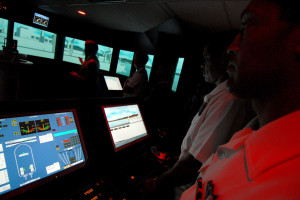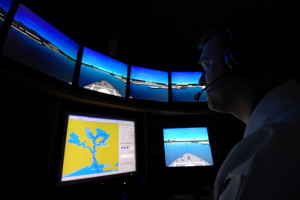
SINGAPORE: A new maritime simulation centre was launched on Friday, as part of a plan to attract more Singaporeans to join the industry.
The centre, which costs some S$4 million, boasts state-of-the-art facilities — including engine room and liquid cargo handling simulators, the latest 240-degree full mission bridge simulator, as well as an electronic chart display and information system.
Called the Wavelink Maritime Simulation Centre, it is one of the first few maritime institutes in Singapore to house four simulation systems in one location.
It will allow maritime officers to get more effective hands-on training in various aspects such as ship manoeuvring and resource management, and prepare themselves for extreme conditions and emergencies without being put through real risks and danger.
They can also learn to use shipboard equipment such as electronic charts, automatic identification systems and radar plotting aids.
The centre, which is housed at the Devan Nair Institute for Employment and Employability Institute in Jurong, is owned by the Singapore Maritime Officers’ Union (SMOU).
By enhancing the training of maritime cadets and officers, the union hopes more Singaporeans will consider seafaring as a career.
SMOU General Secretary Mary Liew said: “Traditionally, seafaring skills are very much time-based learning, that is the longer you work onboard a ship, the better skills you have.
“But now with simulation training, the cadets and officers’ skills are accelerated with real-time feedback in a risk-free environment.
“Thus, they become better officers, have better jobs and better lives. It is a win-win situation for them as well as the shipping companies.”
For a small country that is highly dependent on international trade, the maritime industry is a core pillar of Singapore’s economic development.
It contributes seven per cent of Singapore’s GDP and provides 170,000 jobs.
But out of some 20,000 officers in more than 4,200 Singapore-flagged ships, only 1,605 are Singaporeans.
Ms Liew added: “With this new set-up, the Wavelink Maritime Simulation Centre, we can actually train a thousand (officers) per year, and we look forward to training more of our seafarers, and to give them a hands-on experience.
“Hopefully, we attract more Singaporeans, for them to be more aware of such a career.”
Secretary-General of the National Trades Union Congress, Mr Lim Swee Say, was also at the launch.
He assured the audience that the government and unions will help as many Singaporeans as possible to move into the sector, which offers good career prospects and good salaries.
– CNA/ac
Nigeria Maritime Academy Gets Bridge Simulator

A NAUTIS Full Mission Bridge Simulator was purchased and delivered to the Maritime Academy of Nigeria in Oron. The new simulator will be used to provide qualitative education and training for the merchant Navy and maritime industry in full accordance with international standards.
The Full Mission Bridge Simulator was delivered and installed by VSTEP at the Maritime Academy of Nigeria faculty in Oron. The DNV class B certified simulator includes a GMDSS and Radio Communications simulator and was installed with a 120° external field of view and NAUTIS Instructor station.
The Maritime Academy of Nigeria is a federally owned educational institute in Oron, Akwa Ibom State, Nigeria. It was established in 1979 to educate and train shipboard officers and shore-based management personnel. In 1988 the college’s mandate was expanded to training all levels and categories of personnel for all facets of the Nigerian maritime industry. By the end of 2013, the academy has trained about 5,100 Nigerian Merchant Navy officers and more than 67,000 other workers in marine operations.

The Full Mission Bridge Simulator will allow the academy to expand its training curriculum with certified simulator training courses. The Maritime Academy of Nigeria instructors have received extensive simulator instructor and maintenance training from the VSTEP engineers, allowing them to operate the simulator and provide high quality FMB simulator training to academy students.
Kongsberg to Supply Engine Room Simulator to Ghana
The Regional Maritime University (RMU) has awarded Kongsberg Maritime a contract to deliver its K-Sim Engine simulator for its premises in Accra, Ghana. The highly advanced Full Mission Engine Room Simulator (ERS), which is due for delivery in May 2014 will enable RMU to provide education according to STCW requirements.
RMU is a tertiary institution that gained university status in October 2007. It exists to enhance development of the maritime transport sector and the fishing industry in member states through the maritime education of students, training of marine personnel, research and consultancy and promotion of maritime co-operation.
“One of the drivers for acquiring a new generation ERS was to promote regional co-operation in the maritime industry, focusing on training to ensure sustained growth and development,” comments Augustus Addy-Lamptey, Ag Dean of the Faculty of Engineering, RMU. “The technical capabilities of K-Sim Engine and the long-term training possibilities it gives us will help us to reach our goal of becoming known and recognized as the tertiary institution of choice in advanced maritime education and training, in Africa and beyond.”
The K-Sim Engine delivery for RMU comprises a full-mission ERS approved by DNV-GL according to Standards for Certification 2.14 (2011). Demonstrating the flexibility of K-Sim Engine, four vessel models will be available on the simulator: Trawler, Ferry, Anchor Handling Tug and Supply vessel (AHTS), and a low speed VLCC. Kongsberg Maritime will also deliver eight K-Sim Engine desktop stations, with Ferry, High Speed Craft with waterjet, AHTS vessel and VLCC models installed.
“In addition to commercial vessel training, the RMU wants to start focusing on the offshore industry, so they ordered the AHTS model, our latest K-Sim Engine model,” comments Harald Kluken, Area Sales Manager, Kongsberg Maritime Simulation. “By providing multiple vessels on the same simulator configuration, we have been able to develop a very cost-effective delivery for RMU, which combined with recognition of our technology leadership and ability to become a long term partner helped to ensure our success in this international bid.”
K-Sim Engine is in operation at maritime and offshore training institutes world-wide. It offers a wealth of functionality and configuration possibilities. Functionality at RMU includes 3D applications for Kongsberg Maritime’s BigView interactive mimic panel system, which can visualize in 3D, i.e., fire in a compartment as well as the impact of firefighting actions.
The simulation models feature compressors, purifiers auxiliary generators, oil fired boilers and main engine along with all control, monitoring, emergency and alarm functions ““simulated to high degrees of physical realism and meeting DNV requirements. The Engine control room console also features a separate simulated CCTV for flue gas indication.
Transas Simulator for City of Glasgow College
On March 14, Transas Marine and City of Glasgow College signed a contract to supply a simulation complex. The simulation center in the Riverside campus which is under construction, will be one of the largest, the most up to date and most technically advanced simulation suite in the U.K. Training courses are expected to start in Autumn 2015.
The ship simulator suite forms a core part of the new Riverside Campus and the complex nature of the equipment and fit out require a high degree of integration with the New Campus NPD Co (Scottish Government’s Nonprofit Distributing revenue funded procurement model) design. Transas provided technical integration input into the refinement of design for the New NPD Campus project.
The simulator suite will include a full mission engine room simulator, three simulator labs: for studying of electronic navigation systems, GMDSS training, liquid cargo handling and DP operations training. Ship handling simulators part will house four part-task bridges with 135° visualisation and a 360° full mission ship handling simulator which will be used for advanced training and certification.
Iain Marley, Project Director, City of Glasgow College remarked, “Due to expected growth in maritime training over the coming years and introduction of the Manila Amendments of the Standards for Training, Certification and Watchkeeping (STCW) 2010 conference, the College acknowledges that in order to maintain its position within the sector, both nationally and internationally, that now is an ideal time to enhance the provision of simulation equipment installed previously. The requirement for leadership and management courses at all levels, but particularly at the operational and management levels, as defined in STCW 2010, has also influenced the identification of requirements. This is true particularly in regards to the connectivity of individual items of simulation equipment, as joint training of deck and engineering officers for certain aspects of leadership and management training will now become mandatory. The expected demand for growth in dynamic positioning training has also been a major factor in the design of the simulation equipment.”
The City of Glasgow College was formed in September 2010 from the merger of three existing further education (FE) colleges within central Glasgow including the former Glasgow College of Nautical Studies. The College is now one of the largest FE colleges in Scotland and the only major provider of maritime education and training. Part of the merger strategy included the rationalisation of the estates of the former colleges through the construction of two distinct new city centre campuses (Riverside & City). The New Campus NPD Project will provide modern facilities to enable the College to deliver high class education, in state of the art facilities that will meet the need of the city, Scotland and the wider international market in terms of students and employers.
Kongsberg Delivers Simulator Upgrades
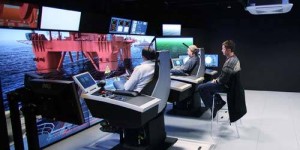
The Simsea AS maritime training center in Haugesund, Norway, has chosen Kongsberg Maritime to support the extension of its offshore simulation facilities with new simulators and significant upgrades to existing simulators.
Kongsberg Maritime has also recently delivered a new rig simulator model at Simsea, based on the Floatel Superior accommodation unit, which is currently in operation in the North Sea. Developed as a part of the K-Sim Offshore simulators installed at Simsea, the new customized model will be used to train semi-submersible rig personnel in advanced operation of Dynamic Positioning (DP), position mooring system (POSMOOR), stability/ballasting and rig move/anchoring.
Floatel International commissioned development of the simulator model to provide training for maritime rig personnel and to support its safety strategy. Simsea has already conducted courses for Floatel International and today the organization boasts significant experience of rig personnel training on Kongsberg Maritime’s simulators.
The new Floatel Superior rig simulation model offers the opportunity to practice on leadership and decision making in emergency and abnormal situations including communication and teamwork, all of which are training fundamentals. K-Sim Offshore has been designed to provide highly realistic, task specific or full vessel training exercises, making it the ideal foundation for such a diverse training program.
“The new rig model in K-Sim Offshore represents a significant boost to training opportunities for maritime rig personnel in Norway and internationally,” says A. Rune Johansen, Managing Director, Simsea AS. “It is a strong training ground not only for personnel on the accommodation units but also in most other mobile rigs used in the oil & gas sector.”
Opened in February 2012 and built on a foundation of Kongsberg simulation technology, Simsea is one of the most advanced offshore simulator training centers in the world. It currently features a number of DP and offshore bridge simulators including a 360 degree visual K-Sim Offshore simulator with interface to a range of specialized task simulators such as ROV, offshore crane and ECDIS for team training of complex offshore operations.
With the delivery of new simulators starting in August 2014, Simsea will introduce more simulation capabilities based on Kongsberg Maritime’s leading K-Sim Offshore simulator platform, including; two new K-Sim Offshore bridges and K-Pos DP systems, and an extension of the existing full-mission bridge with K-Pos DP. All bridges will be according to DNV Class A. An advanced ROV simulator interface and a hydraulic winch simulator for anchor handling as well as a hydrodynamic modeling tool for development of vessel models are included.
Simsea’s ability to offer courses covering individual and best practice team training and crisis management will be significantly enhanced following the upgrades. Most offshore maritime operations will be covered, such as platform support, close proximity, anchor handling, subsea, offshore loading, rig ballast/stability, power management and DP. The facility’s DP training capabilities fulfil the Nautical Institute’s DP training requirements, allowing for a reduction in operating training time at sea, which enables cost savings and safety improvements for intensive Dynamic Positioning Operator training.
“After two years of operation, we are already at the stage of investing further to expand our services to the maritime and offshore industries,” continues Johansen. “Our diverse capabilities have attracted a huge number of course participants so we are keen to keep Kongsberg Maritime on board to ensure our training technology is as advanced, reliable and flexible as possible.”
Navy Unveils Newest Ship Navigation, Bridge Simulator
(navy.mil)
SAN DIEGO (NNS) — Naval Base San Diego hosted a ribbon-cutting ceremony to unveil its newest navigation, seamanship and ship handling trainer (NSST) on June 11.
NSST is a state-of-the art bridge simulator used to train ship crews in navigation and ship handling using virtual technology.
The NSST program was launched to improve training efficiency and effectiveness and to reduce training costs. The program updates the Navy’s current navigation, seamanship and ship handling training systems and provides high fidelity, user-friendly navigation training in all fleet concentration areas and on board Navy warships.
“I’m absolutely delighted to be here to do this ribbon cutting,” said Commander, Naval Surface Forces Vice Adm. Terrance T. Etnyre. “I firmly believe this is going to have a dramatic impact on the ability to train our officers and bridge crews to navigate and perform ship handling.”
The NSST system has already been established in Everett, Wash., Pearl Harbor, Yokosuka and Sasebo, Japan.
“These simulators are designed essentially to create a virtual maritime environment identical to conditions you would experience at sea in a real ship,” said Garland Hardy, a sub-contractor assigned to provide NSST training. “That allows us to provide realistic training to the Navy for all aspects of navigation, ship handling and seamanship. We can teach people how to respond to dangerous situations and potentially catastrophic scenarios in an environment that is completely safe.”
Quartermaster 1st Class (SW) Jose Loya, assigned to Afloat Training Group, Pacific, said the training was very realistic.
“If you know you are going to do an underway replenishment, you can come here, jump on the simulator and try to get the effect,” said Loya. “It’s going to benefit the Navy and all the ship handlers out there.”
For more news from around the fleet, visit www.navy.mil.
SCI Simulator Offers One-on-One Training
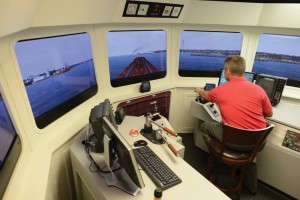
With a new simulator in full operation, SCI helps mariners complete assessments previously only available in large class settings or in the real world when exact conditions could be met on the water. The simulator offers affordable one-on-one assessments to help meet individualized training goals, obtaining credentials for licenses, and radar recertification. For mariners applying for new jobs, it allows them to demonstrate skills to the company.
www.seamenschurch.org
San Jacinto College to Build Maritime Training Center
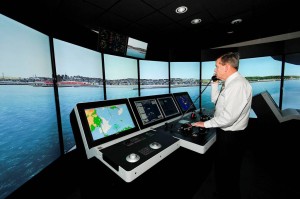
Region’s newest maritime center to showcase room-sized simulators, and training and industry docks
As San Jacinto College prepares to break ground to build the region’s newest maritime training facility, some of the industry’s most sought after training technology has arrived and is awaiting its new home.The college recently received three interactive, full-mission, ship bridge simulators, thanks to a collaborative agreement with the Houston Pilots. They will be moved to the College’s 45,000-square-foot Maritime Technology and Training Center once it opens, projected for mid 2015.
“For our new, waterfront maritime campus, we did our homework and traveled across the country to research exactly what we needed to provide in our new facility in order to be certain that we are offering today’s maritime professionals the best training available anywhere in the country” said Capt. Mitch Schacter, director of the San Jacinto College maritime program.
The simulators are room-sized replicas of ship control bridges, each with a 270-degree view and life-like graphics displayed on fourteen 65-inch monitors. They are equipped with the newest versions Kongsberg’s Polaris 7.2 ship simulation software. They allow trainees to experience different sea conditions from flat calm water to 30-foot high waves, from zero wind to hurricane winds, from clear blue skies to rain, snow, sleet, fog, and sand storms, and include day and night operations.
“This technology allows trainees from almost any type of vessel to experience wind, current and wave action from any direction and at any level of magnitude as well as close quarters interaction with other vessels operating in the same scenario, without ever putting anyone’s life or property in peril,” said Bryan Elliot, maritime instructor and simulator operator. “It provides a very safe and very realistic experience.”
The three simulators are currently operating at the San Jacinto College maritime training center off Highway 225 in Pasadena. Once the new Maritime Technology and Training Center is built along the Port of Houston, the simulators will become a part of a 3,748 square-foot simulation suite with instructor stations, debrief classrooms, and development stations.
In addition, the new facility will house engineering simulators to train maritime engineers for hydraulic, electric, pump control, motor control, heating and air conditioning and refrigeration. Also planned is a full-mission engine room simulator, which will be interactive and interconnected with the bridge simulators to allow vessel management exercises to accommodate deck and engineering officers and crew at the same time, in the same scenario.
Other features will include a 2,000 square-foot multipurpose space for industry conferences and corporate partner meetings along with a fully equipped commercial kitchen to support those functions. The entire building will sit 14 feet above ground and will house 15 classrooms, and administrative support offices. The ground level will showcase a training dock with lifeboats, davits, and fast rescue craft, and a separate industry dock for crew changes. It will also allow vessel specific training for local maritime companies and have an aquatic training facility for sea survival and life raft training, complete with men’s and women’s locker rooms.
“The Center will serve as the premier training facility for regional industry and new maritime technology associate degree program,” said Schacter. “It will house the very latest technology and U.S. Coast Guard-approved curriculum to allow us to continue and to offer much training for captains, mates, deckhands, tankermen and engineers in a safe, professional and productive training environment.”
Marine Pilot Training Partnership Announced
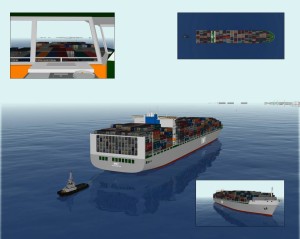
BMT Consultants India (BMT), an international maritime design, engineering and risk management consultancy, announced a partnership with Bibby Ship Management to deliver training for marine pilots. Based at Bibby’s state of the art training center at St Xavier’s Technical Institute in Mumbai, the new partnership will utilize BMT’s REMBRANDT marine maneuvering simulator.
Operating directly from S57 ENC chart data, REMBRANDT is a highly accurate, capable and flexible alternative to Full Mission Bridge (FMB) marine simulators, allowing the user to load any port. REMBRANDT utilizes high fidelity ship models that include over 750 parameters, ensuring that the user experiences identical ship to ship interaction, ship to bank interaction, squat and shallow water effects as the real ship would in the same conditions. Simulations can be replayed in video format with track plots and data information printed or saved electronically, providing an opportunity to analyze the trainees’ performance.
REMBRANDT has enhanced tidal current and wind settings to accommodate the unique features of a given port. It can also provide Client Server, a multi-user mode which enables multiple vessels to operate in a single operational scenario; each with independent human control, making it a powerful and effective training tool. BMT has deployed REMBRANDT worldwide in over 125 projects working with a number of leading ship and terminal operators.
BMT and Bibby Ship Management will be focusing on the Asia Pacific Region, the Persian Gulf, the Indian subcontinent and Africa.
Agarwal (Managing Director) Bibby Ship Management explains: “Our aims and objectives in this partnership are to provide pilotage training of the highest standard, catering for all levels of proficiency ranging from entry level to senior pilots. We will also provide bridge team and resource management training, as well as “Officer of the Watch” training to nautical officers.”
Suren Vakil, Managing Director of BMT Consultants India comments: “BMT has provided specific training and workshops for Adani and Shell pilots at Hazira and all of the pilots working in Mundra. To our credit, the Mundra pilots recently came to BMT for support when they wanted to bring in the biggest container vessel to have berthed at any Indian port. I look forward to a successful partnership where we make our mark in helping to improve the safety of ports in the Indian sub-continent and elsewhere in the Region.”
Spain: Aigua Sea School expands maritime simulator capacity
Palma de Mallorca: Six months after the initial installation of a classroom of NAUTIS Desktop Trainers, the Aigua Sea School in Mallorca has placed a follow-up order to further expand its simulator training capacity.
The follow-up order for NAUTIS simulators was placed after positive feedback from both students and instructors about the ease of use, realism and advanced training possibilities the NAUTIS Desktop Trainers offered.
With a strong reputation in high quality maritime training, Aigua Sea School experienced a strong growth throughout 2013, cumulating in an increase in student applications and official Maritime and Coastguard Agency (MCA) Certification application in January 2014. The MCA application is done using the NAUTIS Desktop Trainers and will give official recognition in the superyachting industry for all Aigua training courses.
NAUTIS Desktop Trainers are high quality simulators that allow training of many competencies, including ECDIS Model Course 1.27, Radar/ARPA Model Course 1.07, VHF Radio Communications, Navigational Instruments (GPS, AIS, Echo Sounder, Speed Log) and advanced ship handling & manoeuvring.
The follow-up order of NAUTIS Desktop Trainers was delivered and installed by VSTEP at the Aigua Sea School headquarters in Palma.
About Aigua Sea School
Aigua Sea School offers the full range of RYA courses in Mallorca and Malta: from learning to sail courses and sea survival, to sailing holidays with tuition and powerboat and jet ski training; from Yachtmaster qualifications and MCA assistance to VHF marine radio communications and navigation theory classes. Its outstanding reputation as a leading RYA Training Centre has been built on recommendation. The positive feedback and a high Yachtmaster success rate, is proof of its commitment to its students.
